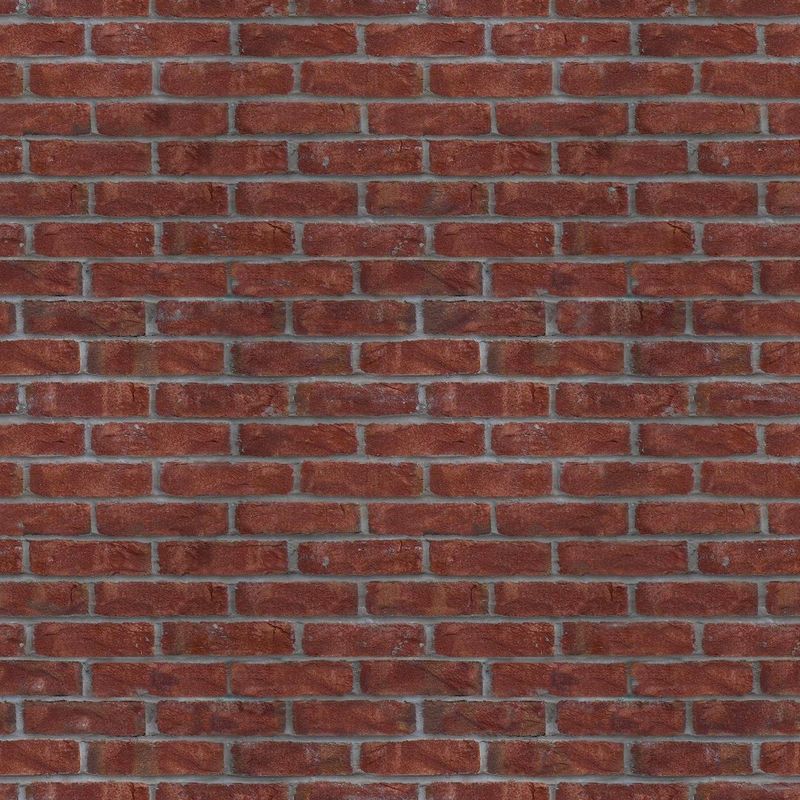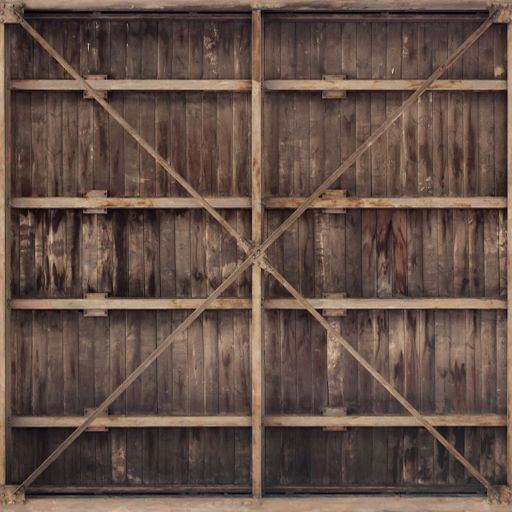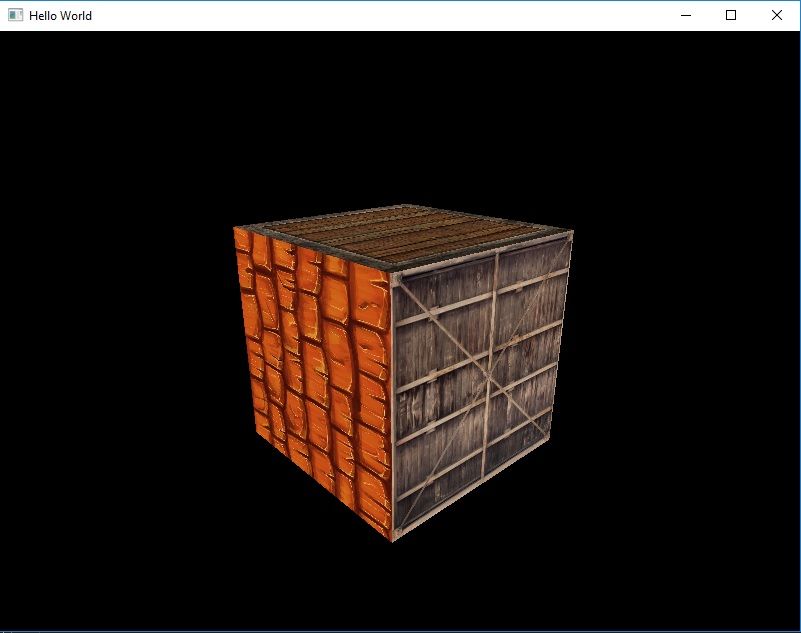Hello again ![]()
Recently I was trying to apply 6 different textures in a cube and I noticed that some textures would not apply correctly, but if i change the texture image with another it works just fine. I can't really understand what's going on. I will also attach the image files. So does this might have to do anything with coding or its just the image fault???
This is a high quality texture 2048x2048 brick1.jpg, which does the following:

And this is another texture 512x512 container.jpg which is getting applied correctly with the exact same texture coordinates as the prev one:

Vertex Shader
#version 330 core
layout(location = 0) in vec3 aPos;
layout(location = 1) in vec3 aNormal;
layout(location = 2) in vec2 aTexCoord;
uniform mat4 model;
uniform mat4 view;
uniform mat4 proj;
out vec2 TexCoord;
void main()
{
gl_Position = proj * view * model * vec4(aPos, 1.0);
TexCoord = aTexCoord;
}
Fragment Shader
#version 330 core
out vec4 Color;
in vec2 TexCoord;
uniform sampler2D diffuse;
void main()
{
Color = texture(diffuse, TexCoord);
}
Texture Loader
Texture::Texture(std::string path, bool trans, int unit)
{
//Reverse the pixels.
stbi_set_flip_vertically_on_load(1);
//Try to load the image.
unsigned char *data = stbi_load(path.c_str(), &m_width, &m_height, &m_channels, 0);
//Image loaded successfully.
if (data)
{
//Generate the texture and bind it.
GLCall(glGenTextures(1, &m_id));
GLCall(glActiveTexture(GL_TEXTURE0 + unit));
GLCall(glBindTexture(GL_TEXTURE_2D, m_id));
//Not Transparent texture.
if (!trans)
{
GLCall(glTexImage2D(GL_TEXTURE_2D, 0, GL_RGB, m_width, m_height, 0, GL_RGB, GL_UNSIGNED_BYTE, data));
}
//Transparent texture.
else
{
GLCall(glTexImage2D(GL_TEXTURE_2D, 0, GL_RGBA, m_width, m_height, 0, GL_RGBA, GL_UNSIGNED_BYTE, data));
}
//Generate mipmaps.
GLCall(glGenerateMipmap(GL_TEXTURE_2D));
//Texture Filters.
GLCall(glTexParameteri(GL_TEXTURE_2D, GL_TEXTURE_WRAP_S, GL_REPEAT));
GLCall(glTexParameteri(GL_TEXTURE_2D, GL_TEXTURE_WRAP_T, GL_REPEAT));
GLCall(glTexParameteri(GL_TEXTURE_2D, GL_TEXTURE_MIN_FILTER, GL_LINEAR));
GLCall(glTexParameteri(GL_TEXTURE_2D, GL_TEXTURE_MAG_FILTER, GL_LINEAR));
}
//Loading Failed.
else
throw EngineError("The was an error loading image: " + path);
//Free the image data.
stbi_image_free(data);
}
Texture::~Texture()
{
}
void Texture::Bind(int unit)
{
GLCall(glActiveTexture(GL_TEXTURE0 + unit));
GLCall(glBindTexture(GL_TEXTURE_2D, m_id));
}Rendering Code:
Renderer::Renderer()
{
float vertices[] = {
// positions // normals // texture coords
-0.5f, -0.5f, -0.5f, 0.0f, 0.0f, -1.0f, 0.0f, 0.0f,
0.5f, -0.5f, -0.5f, 0.0f, 0.0f, -1.0f, 1.0f, 0.0f,
0.5f, 0.5f, -0.5f, 0.0f, 0.0f, -1.0f, 1.0f, 1.0f,
0.5f, 0.5f, -0.5f, 0.0f, 0.0f, -1.0f, 1.0f, 1.0f,
-0.5f, 0.5f, -0.5f, 0.0f, 0.0f, -1.0f, 0.0f, 1.0f,
-0.5f, -0.5f, -0.5f, 0.0f, 0.0f, -1.0f, 0.0f, 0.0f,
-0.5f, -0.5f, 0.5f, 0.0f, 0.0f, 1.0f, 0.0f, 0.0f,
0.5f, -0.5f, 0.5f, 0.0f, 0.0f, 1.0f, 1.0f, 0.0f,
0.5f, 0.5f, 0.5f, 0.0f, 0.0f, 1.0f, 1.0f, 1.0f,
0.5f, 0.5f, 0.5f, 0.0f, 0.0f, 1.0f, 1.0f, 1.0f,
-0.5f, 0.5f, 0.5f, 0.0f, 0.0f, 1.0f, 0.0f, 1.0f,
-0.5f, -0.5f, 0.5f, 0.0f, 0.0f, 1.0f, 0.0f, 0.0f,
-0.5f, 0.5f, 0.5f, -1.0f, 0.0f, 0.0f, 1.0f, 0.0f,
-0.5f, 0.5f, -0.5f, -1.0f, 0.0f, 0.0f, 1.0f, 1.0f,
-0.5f, -0.5f, -0.5f, -1.0f, 0.0f, 0.0f, 0.0f, 1.0f,
-0.5f, -0.5f, -0.5f, -1.0f, 0.0f, 0.0f, 0.0f, 1.0f,
-0.5f, -0.5f, 0.5f, -1.0f, 0.0f, 0.0f, 0.0f, 0.0f,
-0.5f, 0.5f, 0.5f, -1.0f, 0.0f, 0.0f, 1.0f, 0.0f,
0.5f, 0.5f, 0.5f, 1.0f, 0.0f, 0.0f, 1.0f, 0.0f,
0.5f, 0.5f, -0.5f, 1.0f, 0.0f, 0.0f, 1.0f, 1.0f,
0.5f, -0.5f, -0.5f, 1.0f, 0.0f, 0.0f, 0.0f, 1.0f,
0.5f, -0.5f, -0.5f, 1.0f, 0.0f, 0.0f, 0.0f, 1.0f,
0.5f, -0.5f, 0.5f, 1.0f, 0.0f, 0.0f, 0.0f, 0.0f,
0.5f, 0.5f, 0.5f, 1.0f, 0.0f, 0.0f, 1.0f, 0.0f,
-0.5f, -0.5f, -0.5f, 0.0f, -1.0f, 0.0f, 0.0f, 1.0f,
0.5f, -0.5f, -0.5f, 0.0f, -1.0f, 0.0f, 1.0f, 1.0f,
0.5f, -0.5f, 0.5f, 0.0f, -1.0f, 0.0f, 1.0f, 0.0f,
0.5f, -0.5f, 0.5f, 0.0f, -1.0f, 0.0f, 1.0f, 0.0f,
-0.5f, -0.5f, 0.5f, 0.0f, -1.0f, 0.0f, 0.0f, 0.0f,
-0.5f, -0.5f, -0.5f, 0.0f, -1.0f, 0.0f, 0.0f, 1.0f,
-0.5f, 0.5f, -0.5f, 0.0f, 1.0f, 0.0f, 0.0f, 1.0f,
0.5f, 0.5f, -0.5f, 0.0f, 1.0f, 0.0f, 1.0f, 1.0f,
0.5f, 0.5f, 0.5f, 0.0f, 1.0f, 0.0f, 1.0f, 0.0f,
0.5f, 0.5f, 0.5f, 0.0f, 1.0f, 0.0f, 1.0f, 0.0f,
-0.5f, 0.5f, 0.5f, 0.0f, 1.0f, 0.0f, 0.0f, 0.0f,
-0.5f, 0.5f, -0.5f, 0.0f, 1.0f, 0.0f, 0.0f, 1.0f
};
//Create the Vertex Array.
m_vao = new Vao();
//Create the Vertex Buffer.
m_vbo = new Vbo(vertices, sizeof(vertices));
//Create the attributes.
m_attributes = new VertexAttributes();
m_attributes->Push(3);
m_attributes->Push(3);
m_attributes->Push(2);
m_attributes->Commit(m_vbo);
}
Renderer::~Renderer()
{
delete m_vao;
delete m_vbo;
delete m_attributes;
}
void Renderer::DrawArrays(Cube *cube)
{
//Render the cube.
cube->Render();
unsigned int tex = 0;
for (unsigned int i = 0; i < 36; i += 6)
{
if (tex < cube->m_textures.size())
cube->m_textures[tex]->Bind();
GLCall(glDrawArrays(GL_TRIANGLES, i, 6));
tex++;
}
}











